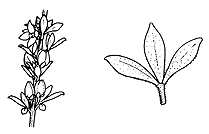Common name: Stiff Boronia
Boronia rigens Cheel APNI* 
Description: Compact dwarf shrub, mostly 0.2–0.4 m high, or rarely to 1 m; branchlets ± pilose.
Leaves mostly 3-foliolate, rarely bippinate; leaflets narrow-elliptic, 3–6 mm long, 1–2 mm wide, apex acute and often recurved, margins entire, glabrous to hirsute, especially along the midvein on lower surface, thick, often glandular-warty; petiole 1–4 mm long.
Inflorescences axillary, usually 1-flowered; pedicel 1–3 mm long. Calyx ± pilose. Petals 2.0–4.0 mm long, imbricate, white to pale pink, glabrous, persistent in fruit.
Cocci glabrous.
Flowering: July–October
Distribution and occurrence: Grows in heath and dry sclerophyll forest on sandstone and other acidic well-drained substrates and stable dunes. North from Bombala to near Mt Coricudgy (east of Rylstone).
NSW subdivisions: CC, CT, ST
Other Australian states: Qld
The morphologiucal variation observed in this species may, with research, warrant taxonomic recognition. Plants found in the Central Coast area can be quite small (often only a few cm high) and have small petals (c. 2 mm long), while those in the Central and Southern Tablelands are more robust and taller, and can have petals to 4 mm long.
Text by M.F. Duretto
Taxon concept: P.H. Weston & M.F. Duretto
APNI* Provides a link to the Australian Plant Name Index (hosted by the Australian National Botanic Gardens) for comprehensive bibliographic data
***The AVH map option provides a detailed interactive Australia wide distribution map drawn from collections held by all major Australian herbaria participating in the Australian Virtual Herbarium project.
|


